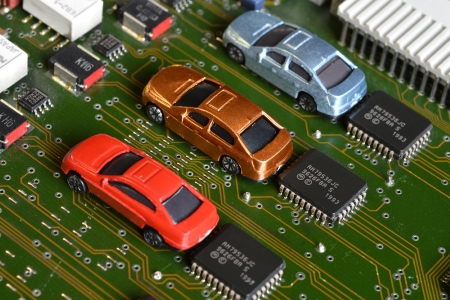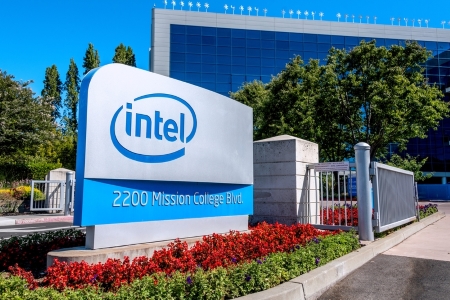“CHIPS and Science Acts Passes!” Indeed, this headline declared the birth of a new bipartisan law. CHIPS and Science Act finally has passed through both the House of Representatives and the Senate.
As you know, if you follow this blog, ER Precision Optics has been mentioning the “CHIPS for America” legislation for months. Now it is a reality, awaiting only president Biden’s signature. He stated, “This is just exactly what we need to be doing to grow our economy now.” Thus, ER Precision Optical now reports to you on what, exactly you see in this Bipartisan Bill and its budget.
Contents and Budget of the CHIPS and Science Act: An Introduction

This Humble Chip is not Easy Or Inexpensive to Manufacture. The CHIPS and Science Money Will Help.
You might have heard that the bill delivers $280 billion “to boost the country’s manufacturing and technological competitiveness against China…” And that is absolutely true.
1. It gives $52 billion dollars to the domestic chip manufacturing industry. These dollars will go in the form of grants and subsidies.
2. Likewise, the Bill authorizes more than $100 billion for technology and sciences investments. Obviously, we want to be better equipped to compete with China in both chip manufacturing and technical innovations.
The science-related money will help scientists innovate in fields like robotics, quantum computing, and artificial intelligence.
3. Therefore, the Chips and Science Bill gives $81 billion to the National Science Foundation. (The NSF)
4. Finally, it grants a 25 percent tax credit “…for investment in semiconductor manufacturing.”
Democracy in Action: Getting Out the Legislative Vote
Clearly, the dire straits of our semiconductor industry became a bipartisan issue. Finally, the Senate cleared the legislation with a 63-33 vote. Likewise, the House of Representatives passed the Chips and Science Bill in a 243-187-1 vote.
Advocates of the legislation declared it was critical to sharpening our global competitive edge. Mainly, the US needs to strengthen manufacturing and technology against the growing accomplishments in China. As you know, China has expressed intentions to monopolize the semiconductor industry.
As the votes arrived to pass the Chips and Science Bill, Senate Majority Leader, Chuck Schumer beamed as he stated, “This Chips and Science bill will create millions of good-paying jobs…” And he added, “It will help lower costs and help protect America’s national security interests…”
The Backstory: How the US Became So Dependent on China’s Chip Industry

The Global Chip Shortage Seriously Affected the U.S. Auto Industry’s Ability to Keep Up With Production. This Sharpened Awareness of Our Chip Manufacturing Needs.
We are proud to see Washington assume more of the burden by subsidizing this critical sector of US technology. How did we get so dependent on China’s semiconductor chip manufacturing business in the first place?
Dozens of years went by as America’s chip industry companies off-shored Chip production. This course seemed golden as it both reduced US labor costs and increased profitability. Then came four historical jolts to our global trade.
- Suddenly we faced the COVID-19 pandemic.
- Then the supply chain issue reared its ugly head.
- Equally disturbing to trade, war broke out between Russia and Ukraine.
- Meanwhile, we encountered “rising technological competition with China…”
Hard Lessons Against Out-Sourcing Critical Chips Manufacturing
The above unanticipated historical events taught us hard lessons against out-sourcing critical manufacturing.
You see, that out-sourcing course proved to be far less than golden. Additionally, it led to almost crippling the auto industry. Tim Ferry is the former tech executive and chief economist at the Washington D.C.-based Coalition for a Prosperous America. He, alarmingly stated, “We are recognizing that we live in a hostile, unpredictable… “post-neo-liberal world.”
Discovering the Significance of the CHIPS and Science Bill
To put it simply, Ferry said, “American companies must accelerate their decoupling from China.” We began to realize we needed to relocate CHIPS manufacture, scientific innovation, and inventive technology” And, he continued that we need “to bring it back home in the good old USA.”
We have started understanding we need to re-negotiate supply chains with dependable allies. Not surprisingly, he singled out “Taiwan as a key partner the U.S. has a lot to learn from.”
Companies Line Up for Funding on CHIPS Projects

Intel is a Giant in U.S. Chips and Science Manufacturing, Research, and Development.
Even before it passed, the CHIPS and Science Act motivated companies to continue or enlarge chip manufacturing projects and manufacturing campuses.
- Now, there’s no doubt that huge facilities for manufacturing semiconductor computer chips will grow with both private and federal funding.
- Both government and business stakeholders are buzzing. “The Act’s arrival has fueled opinions about which firms will obtain federal funds. Experts tell us, on the one hand, “Intel is expected to get the lion’s share as it builds a 20-billion-dollar mega-plant in Ohio…”
- On the other hand, “TSMC, which makes the world’s most advanced chips and is building a $12 billion fab (fabrication facility) in Arizona.” They are also expected to benefit. As you might know, “Taiwan Semiconductor Manufacturing Company, Limited…is known for being the headquarters for the world’s largest dedicated independent semiconductor foundry…” Just as Taiwan helped boost their business, they hope US dollars will help them build on US soil.
Thus, we understand, “Though primarily aimed at boosting American firms, SEMI, a global industry alliance, has called for funding to be inclusively spread across the whole ecosystem…” Apparently, this means funding includes some “foreign firms based in the U.S.” (Some journalists refer to this as friend-sourcing, as opposed to outsourcing.)
Shocking Statistics Drove US Semiconductor Industry into Realizations
Eric Schmidt is the former CEO of Google. He supported these assertions with a frightening statistic. He stated, “We are in a race for technological ascendancy, and it isn’t a level playing field. Over the past decade, China’s investment in R&D has grown at twice the U.S. rate.”
Thus, you can see why we like the new spirit behind the financial boost from the federal sector.
An Important By-Product of Bringing CHIP Manufacture Back Home: National Security
On American soil, we are certain that we will be better able to enhance security. Additionally, we can protect access to critical technology in CHIP manufacturing.
On this point, we know it surprises many Americans that some countries have no respect for copywrites or proprietary ownership of industrial designs and processes. From cartoon characters to technological developments, some countries simply do not recognize the copywriting concept. China is such a country.
This becomes critical when we also recognize that “Chips are also increasingly vital for military applications, enabling more advanced drones, missiles, and algorithms that promise to provide a battlefield advantage.”
Chris Miller is an assistant professor at Tufts University and the author of the forthcoming book, Chip War: The Fight for the World’s Most Critical Technology. He states the obvious need for US proprietary CHIP manufacturing technology as a matter of national security. He says, “There is a really deep interconnection between the chip industry and the US defense industry…”
Concerning China and the US, Miller adds, “Both countries have been gearing up for a future of war that is heavily computing-driven.” However, we must add that if computer chips are the future of war, they are also the future of peace.
The Chips and Science Act: Protecting Vital Technology in Peace and War

The CHIPS and Science Act Funds Provides Additional Research Into Biomedical Science and Quantum Computing.
On the other side of the coin, the average citizen of the US needs vital technical support in everyday life. President Joe Biden sees the CHIPS and Science Act in an economic light.
By bringing manufacture back to the US, he believes we will have better pricing of the goods that require chips. He stated, “We need to lower the cost of automobiles, appliances, smartphones, consumer electronics and so much more.”
Meanwhile, US Commerce Secretary Gina Raimondo’s words unified the civilian and military gains of the CHIPS and Science Act. She named it “a significant step toward securing America’s scientific leadership…”
Then she characterized it as “revitalizing America’s ability to make the chips that keep our cars on the road and fighter jets in the air.”
As always, we thank you for reading the ER Precision Optics blog. And remember, we don’t make chips, but we make the silicon layer critical to most chip designs.


